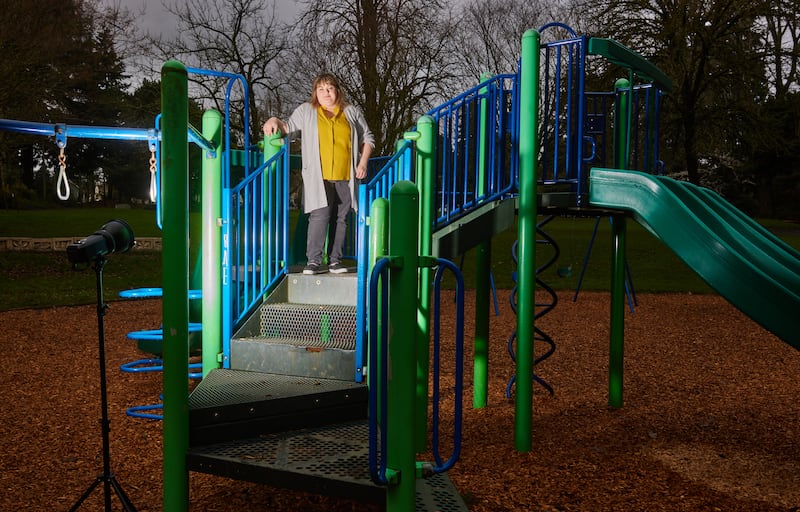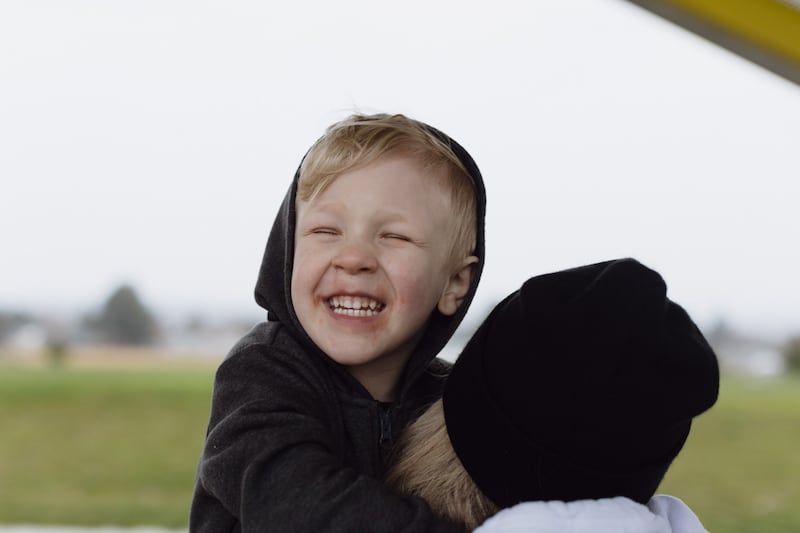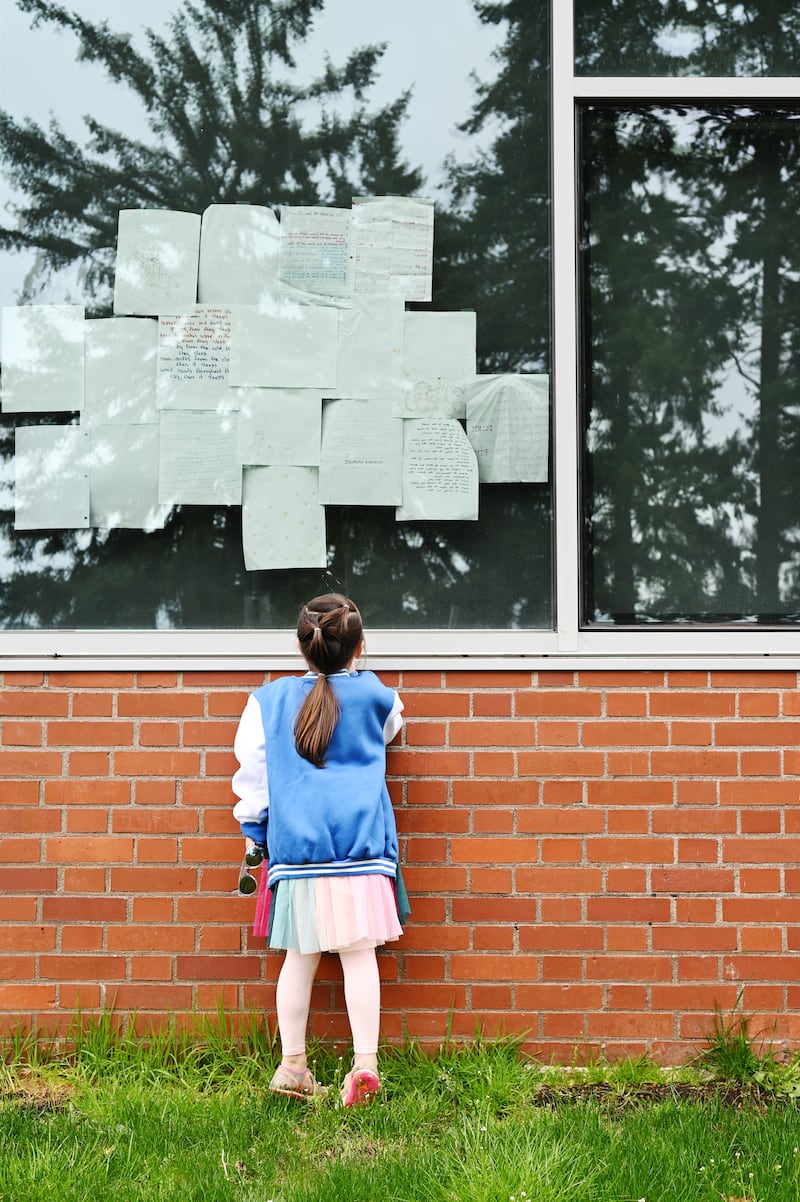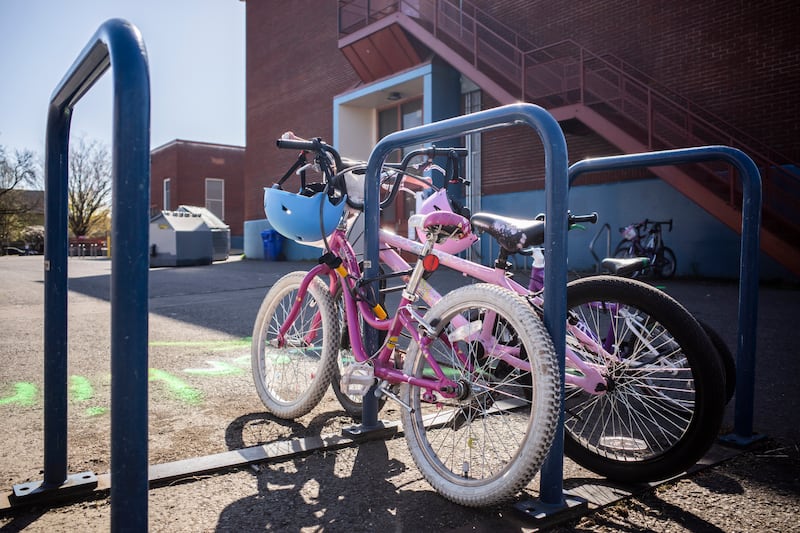Ruby Fuller is a strawberry blond 4-year-old girl who lives in the Woodlawn neighborhood of Northeast Portland and loves rainbows, sparkles and unicorns. A classic pandemic child, she stayed home with her parents from ages 1 to 3. She has a hard time speaking up because she’s never had to do it—she has attentive parents and no siblings to compete with.
“She’s never going to be the one to push her way to the front of the crowd,” says her mother, Tanya Fuller. “Because, also, we don’t let her in crowds.”
Another thing about Ruby? She’s the hot recruit coveted by six local schools for the kindergarten class of 2024.
Ruby is so sought after because Portland elementary school enrollment has plunged by 17.3% since the 2018-19 school year, according to the school district. That’s a loss of 4,300 children, enough to fill about 10 elementary schools.
Overall, Portland schools saw a 7.5% decline in enrollment. In other words, Portland’s K-12 schools are losing students at more than double the rate of the rest of the country and at one and a half times the rate of Oregon schools as a whole (see “The COVID Drop,” below).
That’s an existential threat to Portland Public Schools because funding follows enrollment. Every child who lives within a school’s attendance boundary but does not attend represents dollars walking away—$14,829 of them, to be precise. That’s what PPS spent per pupil in the 2019-20 school year, according to the National Center for Education Statistics.
At the same time, parents now have an abundance of free educational choices, thanks to charter schools, “focus” schools and neighborhood schools. And with fewer children to compete with, principals are telling families on the sly that this will be an easier year than most to get in. Parents will see if that holds true once lottery results are emailed to them this spring.
Parents with incoming kindergartners feel like they’re on a shopping spree. “I wasn’t raised with any kind of school choice, so it feels very privileged to have lots of options,” Tanya Fuller says.
Does she want “project-based learning” and tons of field trips for Ruby? Hit up the Emerson School in Northwest Portland. A hands-on Little House on the Prairie-style Waldorf education? Portland Village School it is. Continue Ruby’s Montessori preschool path but at a charter in North Portland? That would be the Ivy School. One more charter, a private Montessori and finally her neighborhood school, Woodlawn K-5, round out her list.
With more choice comes the nagging guilt that families might be betraying their neighborhood school, a key component of what makes Portland special.
The fact that wealthy families have historically sent their children to public schools just like everyone else has long been a key ingredient in Portland’s civic recipe.
“There’s a lot of school pride in Portland,” says PPS board member Julia Brim-Edwards. “Plumbers, painters, teachers and police all send their kids to school with the children of the governor, the Supreme Court, and CEOs. You have the whole community invested.”
WW sat through kindergarten open houses for the past two months and interviewed families and district leaders to get to the bottom of what is luring Portland parents away from neighborhood schools. As we followed the Fullers and other families through their decisions, three reasons stood out.

Neighborhood schools are losing students because families are leaving Portland.
Some K-5 schools have lost more than a quarter of their students over the past five years, including Abernethy, Alameda, Chapman, Kelly, Rosa Parks and Whitman.
One reason? Families have bailed.
In a recent report, Portland State University’s Population Research Center attributed the school district’s enrollment drop to families moving out of the city or choosing other school options, including private schools, online charter schools or homeschooling during the pandemic.
For the second consecutive year, Multnomah County’s population declined in 2022, about 1.3%, amid widespread civic frustration over a high cost of living and poor municipal services. Thanks to remote work, fewer people feel obligated to live close to downtown. Others can’t afford to.
Whether people left because of livability concerns is hard to tease out from data alone, says Josh Lehner, a state economist. “Multnomah County has been losing young families for most of the last decade already,” he says. “Even during the ‘good times,’ so to speak.”
Angelica Cruz, PPS’s director of early learning, has a pretty good sense of why kids aren’t coming back to school post-pandemic. Cruz meets monthly with a group of teachers, administrators and community organizations to talk about pre-kindergarten through third grade education in Portland.
“Honestly, what we’re hearing from people is that they’re getting pushed out and can’t afford to live in the city anymore,” Cruz says.
In 2022, average Portland rent was $1,614 per month, a 3.7% increase over 2021, according to a report by the city’s Housing Bureau. The median home sales price hit $525,000 in 2021, the report says, a 17% increase since 2016.
Cruz herself is an example of Portland’s cost-of-living problem. She has five children: two in college and three at home. When she moved from Arizona to Portland in 2018 to become the principal at Creston Elementary School in Southeast, she couldn’t afford a home within the district where she was hired to work. They settled in Damascus.
Meanwhile, PPS’s biggest enrollment losses were in the 2020 and 2021 kindergarten classes, which lines up with a birth rate that has plummeted steeply since 2016, according to the report by PSU. There were 30% fewer births to Portland residents in 2021 compared with the 2008 peak. In other words, some of the kindergartners missing from PPS aren’t just tucked away at private schools—they were never born.
Ruby’s mom, Tanya Fuller, chose to have only one child due to the stress of parenting during the pandemic.
“It feels like nobody is having children,” she says. None of her Portland friends has any, despite all being in the second half of their 30s. “Ruby is the spoiled only child of our little friend family.”
Last month, Fuller, 37, listened to the presentation in the “Magnolia” kindergarten classroom at the Portland Village School.
Preschoolers stacked wooden blocks in the back of the room while their parents asked about after care, discipline, the bell schedule, school buses, the talented and gifted program, and “the potty situation.”
By then, she was on her third of five school tours on her quest to find the perfect fit for Ruby. She wants small class sizes. A connection to the community. A disciplinary plan in case of bullying.
“This whole thing is like a part-time job,” says Fuller, who works full time as the manager of a bank’s fraud department. “I feel overwhelmed by choice.”

Neighborhood schools are losing students because parents are afraid for their children’s safety.
This school year alone, there have been shootings near Cleveland, Franklin and Jefferson high schools, resulting in five students being hit by gunfire but no deaths. (Two Portland high school students were shot to death last month in a high-profile triple homicide, but it wasn’t near a campus.)
School shootings are America’s nightmare. But gun violence at Portland Public Schools appears to be a greater problem than in other cities.
The K-12 School Shooting Database reports that gunshots on school grounds are more common here: six incidents in 2022, with few similarly sized cities on the West Coast reporting more than three. That perhaps reflects the spike in homicides among Black youth that began during the pandemic.
In the past few years, the school district has outfitted all of its schools with surveillance cameras and buzzers at main entrances. A 2020 security bond will pay for hardware upgrades to allow all classrooms to be locked from the inside. Returning police officers to school campuses remains a contentious debate.
“If every child feels safe and secure coming into kindergarten, and the families feel safe sending their kids to school, we are hoping that will impact enrollment,” Cruz says. PPS declined to make her available for follow-up questions regarding whether school safety might play a role in declining enrollment.
Erik Hartmann, 48, lives in Grant Park and sends his 6-year-old daughter to kindergarten at a public elementary school. He is seriously considering homeschooling her due to concerns about gun violence. (He plans to see how this school year wraps up before deciding whether to withdraw her.)
“We’re playing Russian roulette every time we send our kids to school,” Hartmann says. “It’s a matter of when, not if, something serious is going to happen.”
Hartmann has a particular expertise: He does counterterrorism work as a security consultant. He believes U.S. schools should have perimeter barriers and guarded entry points.
School safety was top of mind for Susan Snow, 36, when she attended the Buckman Elementary School open house with her 4-year-old son, Rowan, in mid-February.
Snow, stylish with tattoos, platinum hair and white Dr. Martens, rents an apartment in Northeast Portland near Delta Park and is zoned for Faubion School on outer Northeast Dekum Street.
But she might move to inner Northeast soon. She hears gunshots as she works her job from home as a business process consultant for a major health care company. For both of those reasons, she is not considering Faubion for Rowan.
On the Buckman tour, Snow wondered but did not ask if all exterior doors were protected with key fobs, who has access to the playground, and how the children are watched when they are outdoors. Rowan currently attends a small preschool near the airport.
“It is a little hard to swallow the idea of him going to a bigger school when there are all the shootings,” Snow says. “I think of it as being a random thing that could happen.”
Rowan’s father, who wore a nametag that night that said “DADDY,” is zoned for Buckman. He and Snow are no longer together but co-parent harmoniously and attended the kindergarten open house together.
Buckman also accepts lottery students because of its arts program. The dozens of families who attended the open house have a better shot at admission this year than most: Buckman’s enrollment dipped below 400 students this year for the first time in recent memory—a 12% tumble from when the school enrolled 450 students five years ago.

Neighborhood schools are losing students because even Portland liberals are lured by charter and private schools.
Charter schools, which came on the scene in Oregon in 1999, are funded by the government but independently run. Students are admitted via a lottery system. Same goes for the district’s language-immersion programs and focus schools that specialize in areas such as art or science.
This year, about 1,300 children opted to attend Portland Public Schools charter schools rather than their neighborhood school. That’s about 3% of enrollment, according to PPS. Charter schools’ enrollment has dipped 13.4% over the past five years, roughly aligning with the rest of the district.
In other words, charter schools are taking away a same-sized slice of what’s now a smaller pie.
Oregon’s charter school law was hotly debated in the late ‘90s, failing in two state legislative sessions before finally passing. According to news coverage at the time, critics worried that an influx of charter schools would create a two-tiered public school system, pitting neighborhood schools with more marginalized populations against charter schools that would attract more affluent, white students.
Jim Scherzinger served as PPS’s superintendent from 2001 to 2004, when charter schools were just finding their footing.
“Parents wanted to find a program that was special,” he says. “Charter schools had an advantage because in order to exist they had to actually talk with parents about what their educational philosophy was. The neighborhood school was viewed as generic.”
Oregon parents are now accustomed to rethinking their children’s education after the 18 months they did not have full-time, in-person school during the pandemic.
“The pandemic’s impact on enrollment has a long tail,” says board member Brim-Edwards. “If you send your first child to a private school, you’re more likely to send the other children because it’s easier if your kids are in the same school. Parents made some other choices—and that isn’t unreasonable, but you can’t deny that has an impact.”
Lourdes Quintanilla, a pediatric ear, nose and throat doctor, considered the full swath of private, charter and public school choices for her firstborn daughter Eleonora when she attended an open house at the Trackers headquarters on Southeast Milwaukie Avenue.
The space smelled like campfires and whittled sticks as Trackers co-founder Tony Deis explained his outdoor educational philosophy. The Portland Forest School charges $16,950 a year and is taught mostly outside.
“In a classroom, it’s very linear,” he said. “When you’re in a meadow or a forest, everything opens up.”
Quintanilla grew up attending private schools in the U.S. and Mexico. Her husband is an Italian emergency room doctor. Their daughters, ages 3 and 5, speak English, Spanish and Italian.
In addition to the Portland Forest School, Quintanilla is considering Le Monde, a K-8 French-immersion charter school at Southeast 20th Avenue and East Burnside Street, and her neighborhood school, Irvington.
“We want to support our public school system and not contribute to the inequality in society,” Quintanilla says. “It’s very reasonable to try it and maybe it will be awesome. That’s my hope.”
Private and charter schools get a head start on neighborhood schools when it comes to recruiting kindergarten students. Private schools host their open house events around January; charter schools follow in February and March to line up with their lottery period.
Neighborhood schools traditionally host open houses after spring break, says administrator Angelica Cruz, in an effort to reach parents who have fewer resources and options. “Otherwise, we’re mainly connecting with parents who are already shopping for schools,” Cruz says.
Cruz takes pride in the fact that when the first bell rings in August, all PPS kindergartners will have had the opportunity to meet the school principal, their teacher, and a counselor. They can tour their classroom, have a play date with their new classmates at a nearby park, and partake in an ice cream social. Making sure all prospective students have that opportunity, she says, is more important than giving early attention to parents considering several options.
For Quintanilla, the charter school was her front-runner, Irvington was a close second, and she had scratched the Portland Forest School off the list. Turns out open meadows couldn’t quite compete with staying in the neighborhood.
“The community part of it and knowing the families around you and seeing your child thrive? It’s priceless,” she says of Irvington.
But it’s still her second choice behind a charter school with a built-in international community. She’ll send trilingual Eleonora to Irvington if she doesn’t get into Le Monde through its lottery this month.

While everyone affiliated with Portland Public Schools has been talking about the “COVID drop” in enrollment, nobody interviewed has heard whispers about shuttering schools.
Nonetheless, that’s the threat that looms around all conversations about declining enrollment.
Post-pandemic, the Jefferson County School District in suburban Denver voted to close 16 schools; St. Paul, Minn., will close six. Oakland, Calif., planned to close 11 schools but winnowed the list down to six after a backlash that included protests, walkouts and an 18-day hunger strike by two middle school teachers.
“There’s a lot of anxiety and stress at the school level because that’s how they get funded,” says PPS board member Brim-Edwards. “As district leadership, I believe we should share that urgency and create an enrollment plan to get families back into PPS.”
Yet in the reporting of this story, such urgency was hard to spot in the school district.
Andrea Porter-Lopez, the principal of Ruby Fuller’s neighborhood school, Woodlawn K-5, was touchy about the idea that the school’s enrollment is in decline. “Last year, we were down by only eight children, and that’s across all six grades,” she says.
But that’s just one year. Over the past five years, the school’s numbers dropped 18.6%.
“I’m not concerned,” she says. “I don’t control the birth rate in my neighborhood. We just take whoever comes.”
She is more effusive about the benefits Ruby’s family would experience at Woodlawn, including support services like a counselor, social worker and a family engagement coordinator. Woodlawn teaches social justice and early civic engagement; second graders just planted eight new trees.
“There’s a support system that’s built for the child and the family,” Porter-Lopez says. “Whether it’s sports teams, pickup after school, who do you play with on the weekend, how do you hear about things—you get a built-in network.”
All of that sounds pretty sweet to Fuller, who spent most of the pandemic feeling “alone on an island with a baby.”
Also, the charter school shopping spree might have been only a mirage: Last week, the Emerson School emailed Fuller to tell her that Ruby is 11th on the waiting list.
So Fuller’s back online, reading Woodlawn’s parent threads on Facebook, where she just saw that the school’s art teacher might be cut to half time. (The district says that is speculation; the budget will not be final for months.) Parents are planning to testify en masse for more school funding. She is spooked.
Fuller and her husband had a heart-to-heart about the ethics of straying from Woodlawn: “Is this a bad thing to do? Is this a selfish thing to do?” they asked each other.
They vote for public school funding, shop locally, own a home and pay taxes. Charter schools are also public schools.
“Am I taking something from the neighborhood if I don’t put her there? It doesn’t necessarily feel like I am.”

The COVID Drop
Public schools across the nation saw declines in enrollment amid the COVID-19 pandemic. But Portland’s was steeper than most.
U.S.
Students lost between fall 2019 and fall 2021:
1.3 million
Decline:
3%
Oregon
Students lost between fall 2019 and fall 2021:
30,000
Decline:
5%
Portland
Students lost between fall 2019 and fall 2021:
4,000
Decline:
7.5%
Portland elementary schools only*
Students lost between fall 2019 and fall 2021:
4,300
Decline:
17.3%
*Middle school enrollment is flat for this period while high school numbers increased.
Sources: U.S. Department of Education, Oregon Department of Education, Portland Public Schools
